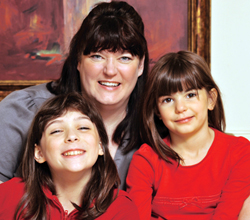 Pediatric surgeon Robert Obermeyer had planned to be off September 15, 2011, to attend a coaching workshop for his son’s hockey team. Instead, he came to work. “I couldn’t stay away,” he says. “I was very worried about that little girl.”
Pediatric surgeon Robert Obermeyer had planned to be off September 15, 2011, to attend a coaching workshop for his son’s hockey team. Instead, he came to work. “I couldn’t stay away,” he says. “I was very worried about that little girl.”
The little girl is 9-year-old Emily Gargiulo. Why she nearly died of a mysterious inflammatory reaction is a frightening reminder that every pediatric surgery, even surgeries often considered “routine,” should be done by pediatric specialists at facilities equipped for children.
Emily’s close call was set in motion on a Sunday last September. “She threw up that morning,” says her mom, Sheila. “At first I thought it was a stomach virus. But by 10 o’clock that night, she could hardly stand up. She was hunched over like a little old lady.”
First thing Monday morning, Sheila rushed Emily to her pediatrician, Dr. Robert Lehman, who diagnosed appendicitis and sent them right to Children’s Hospital. Within hours, Dr. Obermeyer had removed Emily’s ruptured appendix.
“There was a lot of inflammation,” he says, “but everything went as planned. I’ve taken out appendixes that looked much worse than hers did.”
On Tuesday, Emily was recovering so well, there was talk of her going home. “But I wasn’t comfortable with that,” Dr. Obermeyer says. “Something didn’t look right to me, but I couldn’t put my finger on it.”
On Wednesday, Emily seemed worse. “She didn’t have a fever or anything else specific,” the surgeon says. “She just appeared to be a little sicker.”
On Thursday, with his surgical partners up to speed on Emily’s situation, Dr. Obermeyer was about to leave home for the coaching workshop when the phone rang. “One of my partners said Emily was vomiting, and her white count had skyrocketed.” They suspected peritonitis, a dangerous intra-abdominal infection of the membrane that lines the abdominal wall and covers the abdominal organs.
Dr. Obermeyer hurried to the hospital and took Emily back into surgery with his partner Dr. Michele Lombardo. “There was some fluid, which we drained, but no sign of infection. Everything looked pretty normal.”
As Dr. Obermeyer finished the operation, Emily was doing so well that they considered taking her off the ventilator, standard procedure after successful surgery. But because of what his young patient had been through, he decided to keep her on it another day so she could rest.
No one knew the worst was yet to come.
Parents keep a bedside vigil
As with many young families, life at the Gargiulo home in Chesapeake can be hectic. Sheila is a speech pathologist with her own practice. Her husband, Joe, is a captain in the U.S. Merchant Marine, which takes him away from home for weeks at a time.
Along with Emily, Sheila and Joe have another daughter, 6-year-old Natalie. Adding to the happy chaos are dogs Penny and Milo; Emily’s guinea pig, Chocolate; and until this summer, a 17-year-old exchange student from Kenya. After Emily’s second operation, Sheila’s mother flew down from Salamanca, N.Y., so both parents could be at her bedside.
And that’s right where they were, eager to bring their elder daughter home, when the bottom fell out. The second day after her second surgery, Emily’s platelet count plummeted, putting her at risk for internal bleeding. Then she went into septic shock. And then kidney failure.
Emily’s grave condition mystified Dr. Obermeyer, his partners and the half-dozen other CHKD pediatric specialists he met with. There was no good reason to explain why this normally healthy girl was having a life-threatening inflammatory reaction to an ordinary case of appendicitis.
“We were truly concerned that she wouldn’t make it,” says Dr. Obermeyer.
 Because Emily’s surgeries had been done at CHKD, pediatric kidney specialist Reem Raafat was right down the hall. She quickly put Emily on an intensive form of dialysis known as continuous renal replacement therapy. “That’s when the dialysis machine runs 24 hours a day,” Dr. Raafat explains. “So specially trained pediatric dialysis nurses had to be available at all times. And her labs had to be checked every four hours.”
Because Emily’s surgeries had been done at CHKD, pediatric kidney specialist Reem Raafat was right down the hall. She quickly put Emily on an intensive form of dialysis known as continuous renal replacement therapy. “That’s when the dialysis machine runs 24 hours a day,” Dr. Raafat explains. “So specially trained pediatric dialysis nurses had to be available at all times. And her labs had to be checked every four hours.”
As the dialysis stretched out over a week, Joe and Sheila rarely left their daughter’s side. Emily’s doctors and nurses monitored her condition around the clock and coordinated lab tests every four hours. Still, little changed in her condition.
“I know this was a terrifying experience for the parents,” Dr. Obermeyer says. “But I was impressed with how thoughtful and grounded they were.”
Finally, after another few days of supportive team care, lab tests showed some improvement. “The doctors said our daughter was coming back to us,” Sheila remembers.
Day by day, Emily continued getting better. Three-and-a-half weeks after being admitted, she was well enough to be moved from the Pediatric Intensive Care Unit to CHKD’s Inpatient Rehabilitation Unit. Because the doctors and therapists in this unit understand the developing bodies – and minds – of children, they make the hard work of rehabilitation feel more like child’s play.
“When Emily came to us, she was still being fed intravenously,” says Dr. Jean Shelton, a CHKD rehabilitation medicine specialist. “Because of all of the issues in her abdominal area, she had no interest in eating.”
Along with moving Emily from IV feedings to solid food, her team of pediatric rehab nurses and therapists helped her get her strength and balance back. “She was a very brave young lady,” Dr. Shelton adds, “and she made excellent progress.”
When all was said and done, Emily’s seemingly “routine” appendicitis required 24 days of lifesaving treatment in the PICU and eight days of rehab care before she could go home. There, her mom continued the work of getting her daughter’s digestive system back on track. After two more weeks, Emily was strong enough to go back in school.
Specialists search for answers
Even after Emily was home, she was still on the minds of her CHKD medical team. The hospital’s infectious disease specialists, brought in earlier by Dr. Obermeyer, have been delving into why the fourth-grader had such an extreme inflammatory response to appendicitis.
“We’re determining whether an underlying condition played a role,” Dr. Kenji Cunnion says. “Only a few conditions could have caused her kidneys to shut down and her platelet count to drop so dramatically. If it’s one of those, it could be triggered again by something as minor as the flu. We’re waiting for test results to make sure her health isn’t at risk in the future.”
Sheila and Joe are grateful for that concern and for all the care Emily received. “It was like we were the only ones in the hospital,” Sheila says. “Everything was explained to us in detail. No one ever cut us off or said they had to see another patient. I know that if she had been in any other hospital, she would have died.”
Joe’s voice still cracks when he recounts how Emily handled an uncomfortable procedure – and how her nurse reacted. “My daughter said to me, ‘You know, dad, sometimes in life you have to do things that are tough.’ I just about lost it. And when I looked at her nurse, her eyes had welled up, too.”
Emily’s experience, Dr. Obermeyer says, illustrates why it’s crucial that children have surgery in children’s hospitals that have all the pediatric specialists and technology they may need, even when the surgery seems minor.
 “Surgery on a child is never routine,” he says. “An appendectomy is the sort of surgery parents sometimes trust to adult providers in community hospitals. But look at Emily. It took a battery of pediatric specialists to bring her through this and get her back on her feet.”
“Surgery on a child is never routine,” he says. “An appendectomy is the sort of surgery parents sometimes trust to adult providers in community hospitals. But look at Emily. It took a battery of pediatric specialists to bring her through this and get her back on her feet.”
What the Gargiulos requested of friends and neighbors wasn’t routine, either. “People called every day to see what we needed,” Sheila says. Surprisingly, the family requested gift baskets. On the day Emily was discharged, they delivered the gift baskets to each hospital department involved in her care.
“We really appreciated how everyone explained everything to Emily in ways that made sense to her,” Joe says. “They never said, ‘Oh, she’s just a child – she won’t understand.’”
Sheila adds that CHKD is much more than its doctors and nurses. “Everyone involved makes this place special, from the people who clean the rooms to the café workers.”
Months later, the doctors who cared for Emily say they won’t soon forget her. “She had a great effect on me,” Dr. Obermeyer says. “I’m very thankful she’s alive.”
Dr. Raafat was equally moved. “I teared up when I saw Emily for a follow-up visit,” she says. “After what that little girl went through, she looked wonderful.”
Dr. Obermeyer practices with CHKD Surgical Group’s Pediatric Surgery. Dr. Raafat and Dr. Cunnion practice with Children’s Specialty Group, PLLC, at CHKD. Dr. Lehman practices with Pediatric Affiliates of Hampton Roads.
This story was featured in the Winter 2012 issue of KidStuff, a publication of Children's Hospital of The King's Daughters. Click to read more patients' stories.